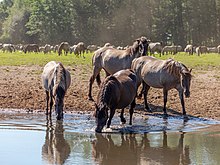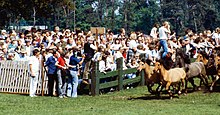Wild horse track
The Wildpferdebahn is a wild horse stud . It is located in the Merfelder Bruch in the Merfeld district of the city of Dülmen in the Münsterland in North Rhine-Westphalia .
In which approximately 360 hectares large protected area about 300 to 400 live Dülmener wild horses . However, since these horses also bear signs of breeding , such as a hanging mane or forehead , the term wildlings is usually used instead of wild horses. The railway in the Merfelder Bruch is the only one left in Central Europe . The wild horse track is a private property of the Duke of Croÿ .
history

The reserve was established in 1847 by Duke Alfred von Croÿ .
The wild horse track is named after the wilderness . In a variant, it is also known as the “wild horse track” based on the trapping system within the area.
The wild horses of Dülmen were first mentioned in a document in 1316. At that time, in addition to fishing and hunting, Herr von Merfeld also secured the right to “wild horses” in this area. The Merfelder Bruch originally comprised an area of around 4,000 hectares, whose ownership and management were shared by the landlord and the farmers of Merfeld.
At the beginning of the 20th century there were still several wilderness areas in Westphalia - areas in which the wild horses lived without human control. With the division of the Marken and the growth of the settlements, these areas gradually disappeared. The division of the communal areas of the Merfelder Bruch between 1840 and 1850 did not, however, result in the end of the wild horses living there. This is thanks to the Dukes of Croÿ. They had the wild horses caught and offered them a new habitat on the wild horse track, which has been preserved to this day.
reserve
The fenced area of the Merfelder Bruch today covers an area of around 3.6 square kilometers. Here the horses are completely left to their own devices. The herd, including foals, consists of around 300 animals on average. The area of pasture, moor, heather, birch scrub and high forest with coniferous forests and oak stands offers varied food and sufficient cover and protection. The wildlings live in the open all year round without additional feeding. Only in severe frost and snow are they supplied with hay from the wild at some feeding stations. The animals do not need stables, they find shelter from snow and rain in the forests. A thick winter coat protects the animals from the cold. Even with diseases and births, the animals have to get along completely without veterinary or other human help. They are therefore completely subject to natural selection, just like in the wild.
Wild horse catch
In order to preserve the wild horses, it is necessary to remove the stallions that are sexually mature from one year of age from the herd in order to avoid rivalries among the stallions. This wild horse catch has taken place every year since 1907 on the last Saturday in May in Merfelder Bruch.
This extraordinary event on the wilderness turns into a crowd puller for the Dülmen population as well as for horse lovers and tourists every year. The one-year-old stallions in the herd are caught by hand. For this the catchers need skill, strength and endurance.
Once the animals have been caught, they are chipped and can be identified for a lifetime as the Duke of Croÿ's Dülmen wild horse. This is followed by a raffle and auction of the stallions. The tickets for the event are usually sold out months in advance.
When wild horses are caught, the young stallions are separated from the herd. Catching the stallions replaces natural selection. Only one stallion stays with the mares in the herd until autumn. If several stallions stayed with the herd, there would be a risk of inbreeding and dangerous rank fights in the limited space of the wild. This would endanger the herd as a whole. Unlike the stallions, however, the mares live and die in the wild.
The yearling stallions that are caught quickly lose their fear of humans and get used to their new surroundings. They are said to have a clever, good-natured, frugal, but above all a relaxed character. They are therefore very popular as riding horses for children or as carriage horses.
opening hours
In addition to catching wild horses on the last Saturday in May, the wild horse track is open from mid-March to early November from 10 a.m. to 6 p.m. on Saturdays, Sundays and public holidays in NRW.
location
You can reach the wild horse course on the country road L 600 between Merfeld and scabs.
Nature reserve
The 291 hectare area, which was placed under nature protection in 1956 , extends east of Maria Veen , a district of the municipality of Reken , and southwest of Merfeld , a district of the city of Dülmen.
The protection is provided for preservation
- to maintain the pastures for the wild horses and their population
- to maintain and promote the near-natural deciduous forest, especially the rare and endangered old alder population
- to maintain and optimize the dry grassland areas that are worthy of protection through grazing.
Individual evidence
- ↑ Duke of Croÿ'sche Verwaltung: Wild horses in the Merfelder Bruch
- ^ City of Dülmen: Wild horses in the Merfelder Bruch
- ↑ World Database on Protected Areas - Wildpferdebahn im Merfelder Bruch (English)
- ^ "Wildpferdebahn" nature reserve (COE-004) in the specialist information system of the State Office for Nature, Environment and Consumer Protection in North Rhine-Westphalia
Web links
- http://www.wildpferde.de/ - website of the Duke of Croÿ'schen administration.
Coordinates: 51 ° 50 ′ 7 ″ N , 7 ° 7 ′ 45 ″ E




